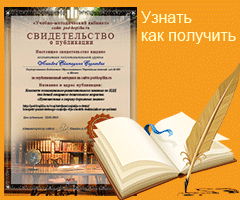Автор: Яковлева Ирина Валерьевна, учитель английского языка МБОУ Марковская СОШ, п. Марковский
Описание материала: Предлагаю вам конспект урока английского языка для старшеклассников с уровнем подготовки Pre-Intermediate по теме «Used to». Данный материал будет полезен учителям английского языка. Конспект урока включает упражнения на закрепление общей темы «used to».
Цель: Закрепить знания учащихся по теме «Оборот "Used to" в английском языке и случаи его употребления», активизировать лексические единицы в речи, систематизировать навык употребления оборота.
Ход урока:
1
Lesson stage: Lead-in
Aim: To generate interest in the topic and set the scene for the lesson.
Procedure: - Write the sentences on the board with the words in the wrong order:
1.eat John to of lot chocolate a used. 2.to do exercise didn`t use any He. 3. use he about Did his to lifestyle worry?
- Put Ss in pairs to put the words in order. Elicit the answers and write them on the board.
(Answers: 1.John used to eat a lot of chocolate. 2.He didn`t used to do any exercise. 3. Did he use to worry about his lifestyle?)
-Ask Ss: Does this tense refer to the present, past or future? (past)
2
Lesson stage: Presentation
Aim: To introduce and clarify the meaning, form and pronunciation of the target language.
Procedure: p.55ex6a
- Focus on the Active grammar box and tell Ss to complete the example sentences with use or used.
Copy the sentences on the board and elicit the answers to complete them.
(Answers:1. +Jeanne Calmet used to ride a bicycle until she was 100.
2. - She didn`t use to worry about things. 3. ?Did she use to have good lifestyle habits?)
-Read through the rule at the top of the box with the Ss and ask: Does Jeanne Calmet used to ride a bicycle refer to a habit or a situation? (habit)
Write an example of a situation on the board, e.g. I used to live in a big house. Ask Ss to turn to the Reference on p57 and ask: Does the form of used to change with he or she? (No)
3
Lesson stage: Practice
Aim: To provide Ss with restricted practice in target language.
Procedure: p.55ex6b
-Ss scan the text for three more examples of this structure.
-Ask various Ss to tell you the examples and write them on the board.
(Answers 1.…she used to be a heavy smoker… .2…she didn`t use to eat very healthily… .3…she used to eat more than two pounds of chocolate… .)
-Point out to Ss that this structure only exists in the past. If we want to say something similar about our habits in the present, we use the adverb of frequency usually.
-Write the following examples on the board: I used to eat a lot of chocolate (past). I usually eat a lot of chocolate (present).
p.55ex7
-Ss complete the sentences.
-Let them compare with a partner and then check the answers with the whole class.
(Answers 1 I used to eat a lot of junk food, but now I don`t. 2 I didn`t use to worry about things, but I do now. 3 Did you use to do regular physical exercise when you were a child? 4 My father used to do a lot of physical exercise, but he stopped in 2005 after an accident. 5 Did people use to be more mentally active 100 years ago? 6 My sister didn`t use to like healthy food, but now she loves it.
p.55ex8
-Ss choose the correct words. Let them compare with a partner and then check the answers with the whole class.
(Answers: 1 used to walk 2 went 3 usually cook 4 didn`t finish 5 used to play
6 didn`t use to do)
4
Lesson stage: Production
Aim: To provide Ss with free, more authentic practice in target language.
Procedure: p.55ex9a
-Focus on the lifelong learning box and read through the tips with the whole class.
-Ask Ss to answer the questions.
-Get feedback from the whole class and encourage them to adopt any good learning habits they don`t already have.
p.55ex9b
-In pairs, Ss think of three more good learning habits.
-Get feedback from various Ss.
If time -- (Optional variation - Ask Ss to individually write one more tip (advice). Monitor their work as they do this. Now ask Ss to mingle, asking the other Ss if they usually do this and trying to convince them to do it if the answer is “no”.)
5
Lesson stage: Listening
Aim: To provide Ss with practice in listening for gist. To provide Ss with practice in listening for detail.
Procedure: p.55ex10
-Focus on the topics in the box and tell Ss to listen to a man talking about his childhood.
-Play the recording and get them to answer the questions. Let them compare with a partner and then elicit the answers from the class.
(Answers 1 He mentions holidays, pets and playing with friends ( a sport, football, is also mentioned in the context of playing with friends, but this is not the main topic). 2 The story about the dog is false.)
- Play the recording again and ask the Ss to note down any extra information the man gives about the three topics and the questions the woman asks at the end to discover the false story. Let them compare with a partner and then get feedback from the whole class.
6
Lesson stage: Follow-up (speaking)
Aim: To personalize topic for Ss. To practice skills.
Procedure: p.55ex11
-Give the Ss a little time to think about their statements and then put them in pairs to tell each other the three things. The listener has to guess which one is false. Encourage them to ask each other questions, as in the listening, to guess the false statement.
If time -- (Optional variation - - Put the Ss in groups of three and tell them that each one has to prepare a short story, using used to, about their childhood. In each group, two Ss should tell a true story and one a false one. Give them time to prepare this and to decide whose story will be false. Each group then tells their three stories to the rest of the class. The other group can ask questions and must finally guess which student is lying.
Optional extension -- Divide the class into 5 groups and give one of the following categories to each group: pets, food, holidays, sports, school. Each group has to think of two questions for their category, e.g. Pets: Did you use to have a dog? Did you use to have a cat? Food: Did you use to like vegetables? Did you use to eat in restaurants?
When they have written their questions, Ss mingle and interview the other Ss in the class. Then they go back to their original group, compare results and present the final results to the rest of the class, e.g. Four Ss used to have a cat, three Ss used to have a dog and seven Ss didn`t use to have a pet.)
Рекомендуем посмотреть:
Внеклассное мероприятие по английскому языку на тему: Хэллоуин, 5 класс
Конспект урока по английскому языку для 5 класса по теме «Времена года»
Конспект интегрированного урока «Английский язык и физика» в 10 классе
Информационные технологии на уроках английского языка
Конспект урока английского языка в 5 классе по теме: Праздники


